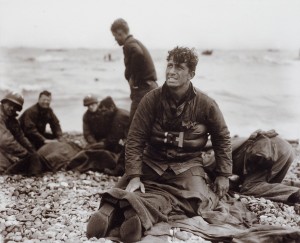The Radical Camera, The Radical Eye
You see a little dark-skinned boy, barely out of diapers, but his face is as wary of the camera as a 40-year-old man. Turning your head to the side, you catch a glimpse of the dour-faced dwarf standing somewhere on the Lower East Side. On another wall, the anguish in a soldier, who covers the body of his comrade on D-Day in Normandy, pops out hauntingly; and then there are the smirks and swagger of that Coney Island foursome, daring the onlooker to respond. You look away, but you can’t help yourself. You look again, then again.
Where am I, you ask. The Jewish Museum in New York City, and from November 4, 2011 through March 25, 2012, it’s where you want to be. The exhibit, The Radical Camera: New York’s Photo League, 1936-1951, in collaboration with the Columbus Museum of Art, is displaying nearly 150 vintage photographs from a compelling and controversial band of photographers. Their unflinching, and sometimes beautiful, honesty is ever present. No subject is too risky for their lens. The world itself is fair game for the taking.
“The portable 35mm camera practically propelled “street photography” into being,” Mason Klein, the co-curator, emphasized. “And it provided first-generation Americans, many of whom could not afford to collect and did not have access to study the fine arts, a way to be creative and make a difference.”
Klein is a tall, affable man—who in his own relaxed, collegiate way—makes the visitor comfortable. In his sunny, book-filled museum headquarters at East 92nd Street and Fifth Avenue, he shared many fascinating aspects of the Photo League’s turbulent history.
Photo League photographers like Lewis Hine, Walter Rosenblum, Aaron Siskind, Sid Grossman, Lisette Modell, W. Eugene Smith and many others; have not been seen in a major exhibition in 30 years. The Jewish Museum’s primary reason for mounting The Radical Camera exhibit is an attempt to rectify the work of the League and the importance of bringing these images to the public again. It is obvious as one enters room after room in the exhibit that this is not merely a patchwork job. Each period in the country’s history, from the earliest beginnings of the League, is documented. The Great Depression, the War Years and the Red Scare, are highlighted in stirring images. This is clearly a labor of love.
One of the most moving testaments to the power of the human subject in the show is the Harlem Document. Its goal was to provide evidence of an impoverished community in peril and advocate for improvement of its living conditions. Ten photographers, over a four-year period, produced dozens of pictures. But only one African American is listed on the project.
“And yet,” Klein explained, “in spite of that, one has to be reminded of the centrality of those American images, the number and force of them throughout the community.”
One of the strongest depictions is by Vivian Cherry, one of the few surviving members of the League, which depicts a young black boy playacting the role of a hanged man.
During the Great Depression years, President Franklin D. Roosevelt instituted massive relief programs as part of the New Deal and funded many art programs for the general public. A few of the League’s members participated in the Farm Security Administration’s efforts, where the emphasis was on the rural poor. According to Klein, the FSA was (more than anything else) propagandizing the pioneer spirit — the American will to overcome any adversity.
“The Photo League wanted to look at its own urban socialistic, diverse terrain. They wanted to look at people like themselves,” he said.
They looked and they clicked. Clothes dripping on tenement walls, hunger and suspicion in a child’s eyes, the sheer weight of exhaustion. And they took these images back to Sid Grossman, their mentor, buoying each other up with their passion. Forerunners like Lewis Hine, who had championed the need for child labor laws, and Paul Strand and Berenice Abbott (already recognized photographers in their own right), became active in an advisory capacity. The Photo League was a school, it provided darkrooms and exhibition space and a place of social get-togethers. “A [type of] camaraderie,” emphasized Klein. “Moreover, photography hadn’t been validated yet as an art form.”
World War II brought incidences of unbelievable risk and bravery. This is no more in evidence than in Walter Rosenblum’s image of the grief-stricken soldier on Omaha Beach during the D-Day rescue.
“Certainly there was heroism, but a horrible irony that after Rosenblum was there with a camera instead of a weapon, this group was blacklisted in 1947 as disloyal,” Klein stated.
(Article continued on next page)

